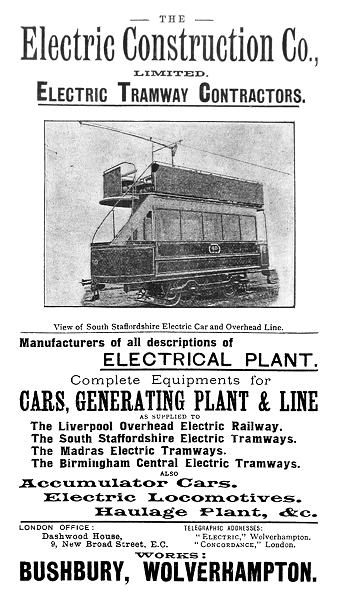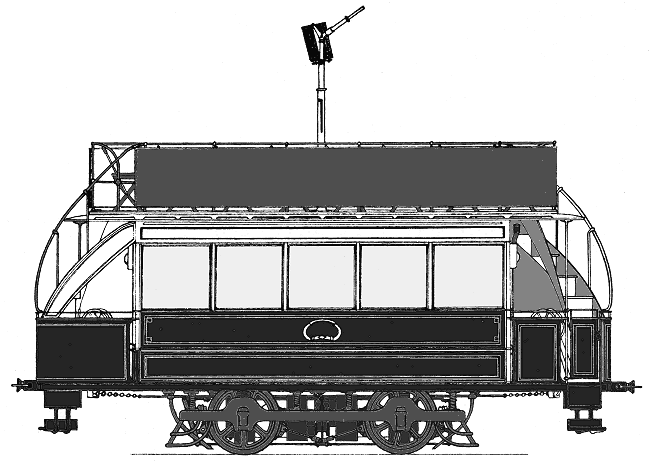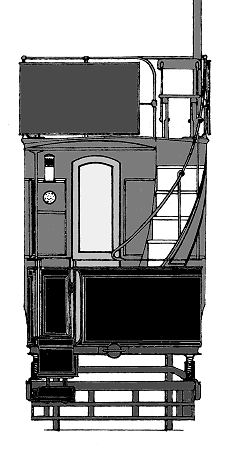| The
South Staffordshire Tramways (Lessee) Company Limited. |
|
Formation
As mentioned in the previous section,
the British Electric Traction Company Limited (BET) had
obtained a controlling interest in the South Staffordshire
Tramways Company on 29th July, 1897. BET took over the
electrified section of the tramway and employed Alfred
Dickinson as manager in overall charge.
The future of the South Staffs' steam
trams looked bleak because it was apparent that the Board of
Trade would not extend the company's licence to operate the
trams indefinitely, especially as Handsworth Council was
greatly opposed to them. At the employees' dinner in March
1898, one of the directors, Samuel Richardson Blundstone
gave a speech in which he said that the company had been
slowly but surely drifting on to rocks. The company had
assets of £50,000 and liabilities of £73,000. It was
proposed that the company should form part of a vast
overhead electric system similar to those in America. He was
clearly stating that the days of steam traction were
numbered.
At the company's annual meeting in May,
the Chairman, William Somers Schuster was asked if anything
had been done about handing over to BET? He responded by
stating that it had already been done, and that had it not
been done, the company would have been wound-up.
|
|

An E.C.C. advert from 1893. |
The local authorities urgently wanted
an improved form of traction on the lines, and so the
company arranged a conference between representatives of the
local authorities from Darlaston, Dudley, Handsworth,
Tipton, Wednesbury, and West Bromwich, and the company's
Chairman William Somers Schuster, and Stephen Sellon, BET's
Chief Engineer. It was presided over by Sir Francis
Marrindin of the Board of Trade.
During the meeting, which took place on
3rd May, 1898 at West Bromwich Town Hall, a discussion was
held about the different traction systems, leasing of lines,
etc. Mr. Schuster announced that the company was promoting a
Bill, paid for by BET, to introduce an improved form of
traction on all of their lines. Copies were to be supplied
to everyone present. The meeting was adjourned for one
month.
In the meantime, the Highway
Sub-Committee appointed by West Bromwich Council
carried out a survey of all systems currently in use, and
concluded that the overhead wire system of electrical
traction was the best option. Having considered the findings
of the sub-committee, the council felt that the way forward
was to purchase the tramways within the borough, upon
expiration of the current lease, and run an overhead wire
system of electrical traction powered by a corporation
generating station. |
|
While this was happening, BET put
together a proposal for the committee, part of which stated that their agreement with
South Staffordshire Tramways included an option of taking a
lease on the whole network with a view to electrifying the
remaining steam sections. It also stated that BET was about
to introduce a Bill in the next session of Parliament in the
name of the South Staffordshire Tramways Company to confirm
the lease and give power to the lessees to convert all or
part of the network to electric traction.
The conference met again as planned,
but adjourned the meeting until 20th July so that members
could consider the BET proposals and the conclusions of the
West Bromwich sub-committee. At the next meeting the members
resolved that all local authorities within the area covered
by the South Staffs network should take steps towards the
purchase of the lines in their district and oppose BET's
Bill. Afterwards Dudley, Walsall, Wednesbury, and West
Bromwich councils confirmed their intention to purchase the
tramways within their areas. Only Coseley, Darlaston,
Handsworth, and Tipton were undecided.
Around November 1898 Alfred Dickinson
resigned as manager of BET's tramways, and was replaced by
Mr. James A. Lycett, BET's Birmingham District
Superintendent.
|

One of the electric tramcars.
| On 8th June, 1899, BET's Bill came
before a House of Lords' sub-committee, but was unsuccessful
because the committee members felt that it did not satisfy
the wishes of the local authorities. After amendments, it was
passed in a shortened form on 9th August as the South
Staffordshire Tramways Act, 1899. The Bill gave the South
Staffordshire Tramways Company powers to lease its tramways
to BET. Afterwards meetings were held between the various
councils affected to decide how best to protect their
interests against the BET Bill. |
|
West Bromwich Council decided to
purchase, and operate its lines independently, and Walsall
decided to apply for a Bill in the next session of
Parliament to do the same, and also extend the network by
over 11
miles.
After
negotiations with South Staffordshire Tramways, BET formed
the South Staffordshire Tramways (Lessee) Company Limited,
registered on 31st July, 1899. The new company took over the
operation of the electrified lines on the South
Staffordshire Tramway network from BET, and for the time
being South Staffordshire Tramways continued to run the
steam lines as before. The new company's Chairman was Emile
Garcke, the Directors were John S. Raworth and James Lycett
from BET and William Somers Schuster, and Samuel Richardson Blundstone
from South Staffs Tramways Company. Secretary H. S. Hodgson. The South
Staffordshire Tramways Company then applied for a Bill to
enable it to sell portions of the tramways to respective
local authorities.
On 23rd
June, 1900 the South Staffordshire Tramways (Lessee) Company
Limited acquired a lease for the whole of the South
Staffordshire Tramways system. Annual rent was to be paid,
after an initial payment of £4,500 at £3,000 plus 1¼ pence
per mile run after the first 864,000 car miles. The annual
rent for Pleck generating station and the 16 existing cars
was five percent of their capital value. When the lease took
effect, James Lycett became Managing Director, Mr. J. J.
Robins became Managing Engineer, and Mr. H. Hatchett became
Traffic Manager.
|

The front of an electric tramcar. |
|
The South
Staffordshire Tramways Company's Bill was passed as the
South Staffordshire Tramways Act, 1900 which enabled the
company to sell parts of the network to local authorities.
The next
section deals with the response of the local authorities to
the potential sale or lease.
|
 |
|
 |
|
 |
|
Return to the
S. Staffs Co. |
|
Return to the
electric trams menu |
|
Proceed to
A Rocky Road |
|